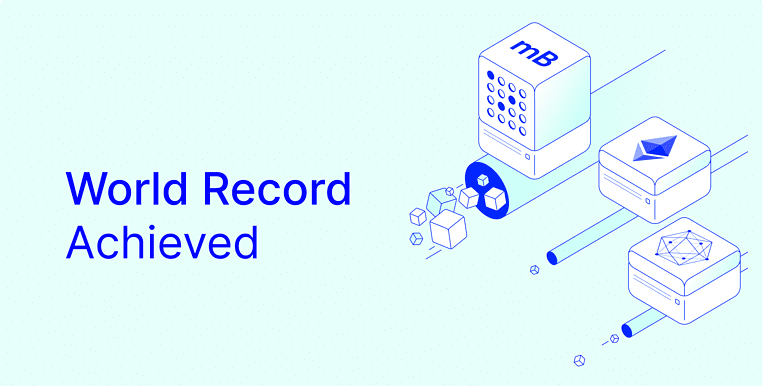At mintBlue, they have recently been working on a blockchain-as-a-service (BaaS) platform. Now they have processed more than 50 million transactions within 24 hours, proving the scalability of the public blockchain. We talked about it with CEO Niels van den Bergh and CIO Pieter Den Dooven.
mintBlue‘s record shows that the public blockchain is a working infrastructure, Van den Bergh makes clear to us. The figures the company cites for comparison are the averages of the Ethereum and Bitcoin blockchains, which are somewhat more familiar to the general public. These blockchains handle 1.2 million transactions per day and 300,000 transactions per day, respectively, mintBlue states. The public blockchain, which is the foundation of mintBlue’s infrastructure, runs an average of 5 million to 20 million transactions, according to Den Dooven’s figures.
“We are picking up a lot of nerves to break the record in one day,” Van den Bergh points out. It involves simulation of documents in UBL format (contracts, certificates, invoices, receipts, order forms), where authenticity and interoperability are important.
Focus on enterprise and verification
So the successful attempt to process 50.53 million transactions should primarily demonstrate the platform’s ability to handle storage from large enterprise environments. For that, of course, it is important to know what mintBlue’s blockchain technology does. “You have to see us as a kind of Ziggo or T-Mobile,” Van den Bergh explains. “Through our platform, you can access the public blockchain without being tied to us. You have the keys, you are the data owner. And companies can switch from mintBlue to whatever. The public blockchain is just always available.”
In explaining the technology, Van den Bergh en Den Dooven also emphasize the fact that mintBlue is on the enterprise side of blockchain and verification is therefore important. “You have the cryptocurrency side of blockchain, which is about speculation. And you have the more enterprise blockchain side where we are. What is fundamentally different is the perception of decentralization,” Van den Bergh states. He is referring to the view on the cryptocurrency side, where there is an assumption that every user has to participate to verify the blockchain network. Each user immediately spins up their own node, because “otherwise it’s not decentralized.”
At mintBlue and in the public enterprise blockchain world, they look at this differently. Van den Bergh makes an analogy: “Do you think everyone should be allowed to build a bridge today? No, you only trust that bridge if an architect who has invested in his education designed it. Otherwise, it’s dangerous. Now back to the blockchain; do you think everyone should validate the network? No, only service providers who invest in professional hardware and skills. Otherwise it’s too slow and too expensive.”
The record of 50.53 million transactions in 24 hours is proof that it can handle, for example, all the transactions of iDeal (2.4 million transactions per day). Also, mintBlue compares it to processing almost three times a transaction of all Dutch citizens in one day.
mintBlue is an access provider for a network of data centers offering capacity. Data centers comply with local laws and have the hardware to process transactions on a large scale. Van den Bergh: “It’s an open network. That is crucial, that not like closed networks it is chosen who can and cannot get in. It is permissive. Anyone can download the protocol with their data center and go and verify it. That makes it open and so you can verify each other’s information. You don’t have to rely on a central party then. So you maintain all the standards and values of the public blockchain, but can really run commercial production applications
Trust and data sharing
In our conversation with Van den Bergh and Den Dooven, analogies and examples also frequently come up, to clarify where mintBlue sees its utility. Also when we talk a bit more about the problems the company perceives in the market today. They cite the various chat apps and streaming services. Consumers today have dozens to hundreds of accounts for those types of services. It has led to a lot of different ecosystems and data silos.
mintBlue is convinced that blockchain can play a role if you want to change that. In their view, the technology is suitable for getting parties to trust each other, exchange data in the right way and support interaction between systems. This, they say, could lead, for example, to an app with all the movies and series from the various streaming services consumers subscribe to.
Den Dooven points out that while there are currently options technically, by exchanging data via API connections, it is not ideal. “What Web3 proposes is to collaborate on a shared data layer. The applications you use interface your information from that shared data layer. You disconnect the app from the data, so to speak, and give the user data ownership and thus control over which app gets to see data,” Den Dooven explains.
Experiment
The record of mintBlue is mainly a confirmation that the technology can offer sufficient capabilities. Van den Bergh and Den Dooven therefore like to see more companies experimenting with the public blockchain. Now companies are mostly open to a blockchain prototype when there is real vision on the part of management, Van den Bergh argues.
“Exactly these companies hire us to test blockchain. They want to know how it works and exactly what to look out for. Then we come up with a use case that we will work on. We test it in a test environment and deploy it to the public infrastructure. We’ve already done that a number of times. Now we’re trying to move more and more toward deployment. We built mintBlue so anyone can prototype in 20 minutes, and set up a full-fledged enterprise implementation in two hours,” Van den Bergh said.
Meanwhile, for example, projects have been completed to make e-invoicing more secure on the blockchain by guiding automated identity verification and auditing. One such project came about in cooperation with Visma | yuki. However, Van den Bergh does believe that all types of businesses can use blockchain technology, from small to large. “We have helped several large enterprise companies, but also have a self-service option. With that, for example, a startup or SME can create an account, read the documentation and get a piece of storage for free to experiment and see how it works.”
They also cite current events, in the form of the Silicon Valley Bank fiasco, for the versatility of the technology. “There are all kinds of interoperability problems between banks. Because there was no transparency about where SVB had put its money, there was a huge meltdown. Is it about risky assets or not? That ambiguity is there because of all the data silos. Now there is a kind of chain reaction because it is all out of whack,” observes the mintBlue CEO.
All in all, as far as Van den Bergh and Den Dooven are concerned, there are more than enough options for using the public blockchain to address current data problems. The record 50.53 million transactions should show that the technology is at least ready for that.
In addition, mintBlue shares the following information with us: The average enterprise blockchain integration takes two hours to implement, without special blockchain development knowledge. In fact, anyone can put a transaction on the blockchain in just 20 minutes, using mintBlue’s console.


